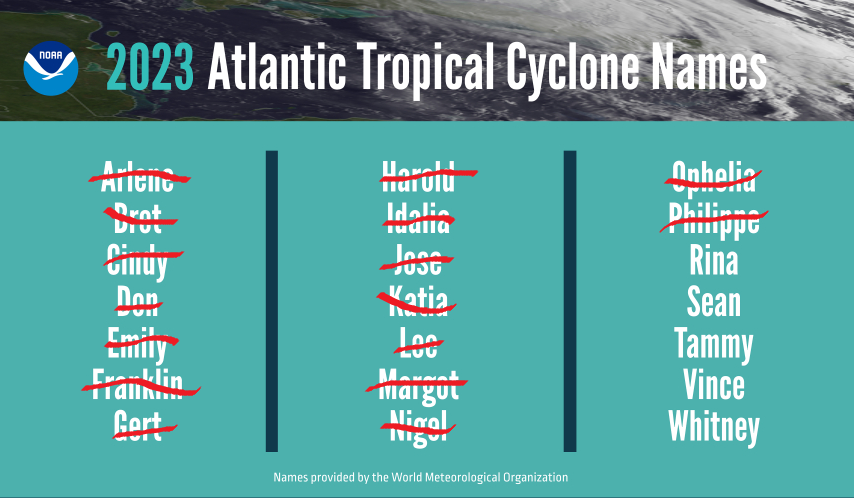Hurricane season has 1 month-plus to go and only 2 storm names left. What happens then?
With just over a month yet to go in the 2023 Atlantic hurricane season, we're running out of names.
Nineteen of the 21 names for this season have been used. There are two names left on the list now that Hurricane Tammy is in the Atlantic.
What would happen if we use up all the names on the list for the season, and who comes up with those names? Here are answers to your questions.
What names are left in the 2023 Atlantic hurricane season?

There are two names that haven't been used as of 11 a.m. Oct. 22: Vince and Whitney.
Who comes up with the list of names for tropical cyclones?
Since 1953, Atlantic tropical storms were named from lists originated by the National Hurricane Center.
Today, they are maintained and updated by an international committee of the World Meteorological Organization.
Originally, name lists used only women's names. In 1979, men's names were introduced and now alternate with the women's names.
In case you're wondering, storm names aren't selected from any specific person
Tropical cyclones/hurricanes/typhoons are not named after any particular person, the WMO said.
"The names selected are those that are familiar to the people in each region. Storms are named for people to easily understand and remember the tropical cyclone/hurricane/typhoon in their region."
Names for tropical storms and hurricanes are reused
Can't see the lists? Open in a new browser.
Six lists are used in rotation. Names used in 2023 will be used again in 2029.
There is an exception to reusing hurricane names
"The only time that there is a change in the list is if a storm is so deadly or costly that the future use of its name on a different storm would be inappropriate for reasons of sensitivity," according to the WMO.
The nation hit hardest by a storm can request its name be removed.
During its annual meeting, the WMO Tropical Cyclone Committees can strike a name from the list and select another name to replace it.
When a storm name is retired from the Atlantic's list, member countries of the WMO from that region select a new name. For Atlantic storms, the name can be French, Spanish or English, reflecting the languages of residents of countries that could be hit by a hurricane.
That was the case with Hurricane Ian, which destroyed portions of Southwest Florida in September 2022 when it made landfall as a Category 4 hurricane.
➤ Hurricane Ian: Then and now in Southwest Florida
Also removed from the list last year was Fiona, which hit the Lesser Antilles, Puerto Rico, Dominican Republic, the Turks and Caicos, and finally Canada.
Farrah will be used to replace Fiona in the list of names, and Idris will replace Ian.
No more Ian or Fiona: Ian, Fiona retired from list of hurricane names because of 2022 death and destruction
What happens if all names for a year are used?
If all 21 names are used for Atlantic-basin storms, an approved list of alternate names comes into play.
These names also are approved by the WMO.
For Atlantic storms, the alternate or supplemental list of names are:
Adria
Braylen
Caridad
Deshawn
Emery
Foster
Gemma
Heath
Isla
Jacobus
Kenzie
Lucio
Makayla
Nolan
Orlanda
Pax
Ronin
Sophie
Tayshaun
Viviana
Will
Climate change and hurricanes: Is climate change fueling massive hurricanes in the Atlantic? Here's what science says.
What happened to Greek alphabet names for tropical storms and hurricanes?
In March 2021, the WMO announced Greek names would no longer be used.
The use of Greek alphabet names "creates a distraction from the communication of hazard and storm warnings and is potentially confusing," the WMO said.
The decision was made after a record-breaking 31 storms in the Atlantic basin in 2020, which not only used the entire list for the year but also used Alpha, Beta, Gamma, Epsilon, Zeta, Eta, Theta and Iota.
Latest forecasts for 2023 hurricane season
The National Oceanic and Atmospheric Administration updated its forecast Aug. 10, predicting 14-21 named storms to develop this year, of which six to 11 could become hurricanes with two to five of those that could become major hurricanes.
AccuWeather's updated forecast released Sept. 7, predicted:
13-17 named storms (which are tropical storms and hurricanes)
4-8 hurricanes
3-5 major hurricanes
2-4 direct impacts for the United States, including Puerto Rico and the Virgin Islands.
Colorado State University's updated forecast released Aug. 3 predicted 18 named storms and nine hurricanes. Four of the hurricanes are forecast to become major storms, of Category 3 or higher.
When does 2023 Atlantic hurricane season end?
The 2023 Atlantic hurricane season got off to a quick start, with the birth of Tropical Depression Two on the first day of the season June 1. It strengthened into Tropical Storm Arlene June 2.
The Atlantic hurricane season runs from June 1 through Nov. 30 and on June 1, a tropical depression formed in the Gulf of Mexico. By the next day, the first named storm of season was born: Arlene.
Tropical storms Bret and Cindy also developed during the month.
June's named storms: As hurricane season predictions inch upward, let's look back at June's named storms
Activity slowed down in July, with only one named storm: Hurricane Don.
Don became the first hurricane of the 2023 season. And it formed much earlier than normal.
July's named storms: With busiest time of Atlantic hurricane season ahead, here's what happened in July
The tropics made up for lost time in August, with six named storms, including the season's first two major hurricanes and the first to make landfall in the U.S., hitting Florida's Big Bend area.
August's named storms: Six named storms developed in tropics in August. Let's look back at 'above-normal' month
This article originally appeared on Treasure Coast Newspapers: 2023 hurricane names: When list runs out, alternate WMO list used

